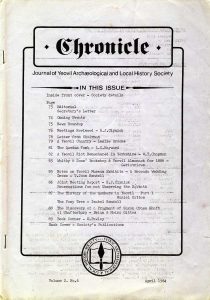1984-Apr-pg85-6_Notes on Yeovil Museum Exhibits No4 – A Brocade Wedding Dress
This article came from the Chronicle published April 1984. Page 85-6
Notes on Yeovil Museum Exhibits No4 – A Brocade Wedding Dress
Author: T.Joan Rendell
In September 1983 the Yeovil Museum was fortunate to be the recipient of a most attractive wedding gown dating from c.1877.
This is an interesting garment as it is not only a completely typical example of its period, but is made from a very beautiful brocade, said by the donor to have been manufactured in Lyons, the famous French centre for silk weaving. This material has been combined with heavy quality deep cream coloured satin probably from the same area.
The dress is cut in a ‘Princess’ line, much worn at that time, probably because the then Princess of Wales, later Queen Alexandra, was a very fashionable young lady, who had adopted this style. The front and back are of satin and the side panels in brocade, the sleeves are long and narrow and also in satin, finished at the cuffs with pleated net frills and small posies of orange blossom.
The front of the skirt is draped horizontally with a separately attached satin panel trimmed at the bottom with a six inch long silk ribbon fringe. This is caught up at the right side with a large posy of waxed orange blossom and several small posies had been distributed round the edges of the panel, but most of these are now gone.
It appears, from the construction of the dress, that this drapery had been added at a later date, probably a year or two after the dress was made, when this kind of decoration became the mode, and the wearer still had some of the original satin in her possession. The panel was hanging by a few threads when it came into the museum and there is no indication whatsoever of its ever having been attached to the original dress. The only joining is by these obviously unprofessional cobbling stitches, possibly done hastily by the owner for some unexpected occasion.
By far the most outstanding feature of the gown is the bustle at the back which finishes in an elaborate train. The bustle, which had started in the early 1870’s nearly at waist level, gradually slipped down the back of the dress till it reached to just below the knee by the late 1870’s. Below the bustle, the train spreads out and is displayed in all its glory, trailing on the floor. The bustle itself is draped in loops and folds and these are secured inside by eight or nine tapes and bows. The study of a considerable number of fashion plates was necessary before it was possible to arrange the drapery in the correct manner, an art that this generation knows nothing about!
The bottom of the satin train is finished with vandyked points about four inches long, bound with self material, beneath which is a hem of the brocade. Between the points and covering the brocade hem is a pleated net frill about four inches wide. The entire hem is also bordered with a pleated net frill two inches wide.
The dress is lined throughout with stiff muslin, canvas, and silk. The fastening is from the shoulder down to the hips on the left side, where the brocade and satin join. Hooks and eyes are used. All the eyes are hand-embroidered bars.
The gown would have been worn with an elaborate coiffure of large curls piled high on the top of the head, and crowned with flowers. Down the back of the head and over one shoulder long corkscrew curls would lie. Covering everything from the high headdress to beyond the end of the train would be the bridal veil. This would normally be made in plain tulle with a wide hem stitched with a thick silk thread as its only ornament. A fairly small bouquet would be carried, probably made of all white flowers.
This dress is now displayed with appropriate accessories from the museum’s collection and is well worth seeing.
